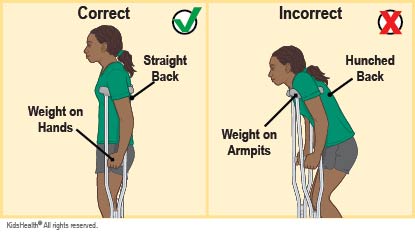The anterior cruciate ligament (ACL) is one of the ligaments in the knee joint. A ligament is a tough, flexible band that holds the bones and cartilage of a joint together.
Your child had surgery to fix a torn ACL and is now ready to go home. They will likely go home with a leg brace and crutches. Most children are back to all regular activities and sports 6–12 months after surgery.
Follow these instructions to care for your child as they recover.

Follow your surgeon's instructions for:
- Giving medicines for pain. These may include prescription pain medicine, acetaminophen (Tylenol® or a store brand), or ibuprofen (Advil®, Motrin®, or a store brand). Some prescription pain medicines also include acetaminophen or ibuprofen. To avoid giving too much, give the medicines exactly as your health care provider recommends.
- Using the brace and crutches.
- Any exercises and stretches your child should do.
- Which activities are OK and which to avoid.
- When it is OK to go back to sports and activities.
- When your child can bathe.
- Caring for the bandages. This includes:
- When to take the bandages off after surgery
- Whether you need to put new bandages on
- Whether your child should wear a compression bandage or sleeve
- Keeping the bandages dry during bathing by covering the knee with plastic wrap or a cut plastic bag and taping it in place
- Starting physical therapy (PT) to:
- Improve movement and flexibility
- Regain strength in the knee, thigh, and shin muscles
- Improve balance
- When to follow up.
General care:
- To help with swelling:
- Place ice wrapped in a towel on the knee for about 20 minutes every 1–2 hours.
- While your child is sitting or lying down, raise the leg by propping it up on pillows.
- Help your child find ways to stay busy during the recovery. For example, they can stay involved in sports by keeping score or by being a team manager. Or they can try a new hobby like playing the guitar, painting, or drawing.

Your child has chest pain, shortness of breath, severe calf pain, or a very swollen calf. These can be signs of a blood clot in the leg, which is a very rare problem that can happen after surgery.

What happens during ACL surgery? The surgeon uses a graft (piece of tissue) to rebuild the ACL. The graft can be a tendon — with or without bones attached to it — from the patient's own body (an autograft), from someone else who donated the tendon (an allograft), or a combination of both. Your surgeon may use anchors and screws to secure the new ACL to the knee.
When can my teen drive? Teens can start driving again after surgery if:
- They are not taking any prescription pain medicines.
- The surgeon says it's OK.
How can we prevent another ACL tear? There are programs that may help prevent another ACL tear. These programs teach movement patterns that lower the risk of injury, especially while jumping, landing, and changing direction. Ask your health care provider or physical therapist whether this type of program is right for your child.




